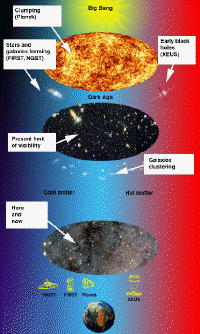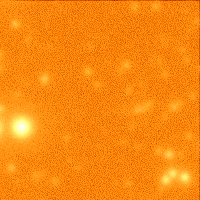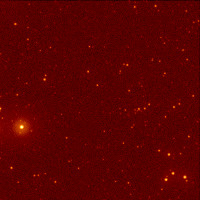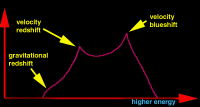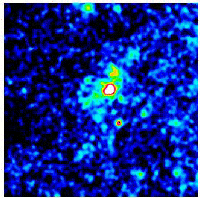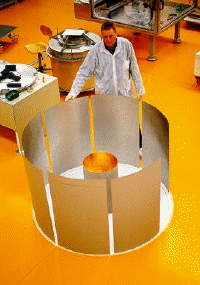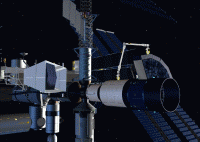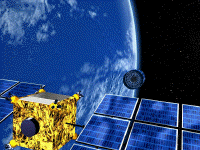The Future
When the Universe was very young
The main target for XEUS is a background glow of X-rays that seems to fill the entire sky. Beyond our own Galaxy, the assembly of billions of stars that we call the Milky Way, astronomers see a wide Universe lit by billions of such galaxies. As telescopes peer deeper into space they look farther back in time. Light from the most distant galaxies takes about ten billion years to reach us, and we see them in their infancy. Look beyond them and you return to a Dark Age without stars, when the young cosmos was pregnant with unborn galaxies. Many of the background X-rays may come from that Dark Age, enabling XEUS to contribute big discoveries about the very young Universe.
Figure 2. Homing in on the Dark Age. While other space telescopes will examine the progress from gas clumps to galaxies, XEUS will look for hotter features of the early Universe, including black holes and the first clusters of galaxies.
The events surrounding the birth of the first stars and galaxies are the theme of several new space missions. From before the Dark Age, at the extreme limit of the observable Universe, comes the microwave background radiation, emitted at a time when nothing existed except a great mass of unidentified dark matter and a vast cloud of helium and hydrogen gas. ESA's Planck mission (2007) will chart the regions of comparatively dense gas that gravity could grab and fashion into compacted objects. Infrared rays of long wavelength will reveal to ESA's FIRST mission (2007) the early assembly of stars and the first dust created by explosions of burnt-out stars. As for visible light from the earliest stars and galaxies, that has been shifted by the expansion of the Universe to become short-wavelength infrared rays, to which the NASA-ESA Next Generation Space Telescope (2008) will be specially tuned.
XEUS offers a hotter view of the young Universe. Our eyes are tuned to sunlight radiated at a temperature of 5 500°C, which is typical of visible starlight yet very cool by comparison with the millions of degrees needed to make X-rays. Microwave and infrared rays, to be studied by the other space telescopes mentioned, come from even cooler sources. Yet most of the observable matter in the Universe today is in a hot state, radiating short-wavelength ultraviolet rays and X-rays. Massive clouds of gas at a very high temperature fill the spaces between clustered galaxies.
How did the Universe get so hot? The only adequate source of energy is gravity, dragging material together in defiance of the general expansion of the Universe. It is like the release of energy in a waterfall, but on a much grander scale. Whenever our Milky Way makes a new star, a collapsing cloud of gas achieves temperatures in the core sufficient to ignite the nuclear reactions that power the star. The real problem is to stop the collapsing gas from becoming so hot that it blows itself apart before it can make a star. Nature overcomes this snag by radiating energy from molecules and dust in the gas cloud.
Conditions in the primeval Universe were quite different from those prevailing in the Milky Way today. With few pre-existing molecules and no dust available for cooling (so the theory goes) only the most massive clouds could collapse. And they would make, not stars, but black holes. That is why theorists suspect that giant black holes, a million times heavier than the Sun, may have been among the earliest objects created in the Universe. X-rays produced in the vicinity of many such giant black holes could explain the cosmic X-ray background.
Spotting the primeval black holes
To confirm that black holes were commonplace in the Dark Age of the Universe requires an X-ray telescope far more sensitive even than ESA's XMM-Newton (1999). Even though XMM-Newton has an unprecedented capacity for collecting cosmic X-rays, it is not expected to pick out the individual sources of the most distant X-ray emissions. XEUS 1 will be 40 times more powerful than XMM-Newton, and XEUS 2, 200 times, allowing very faint objects to be detected and identified. The huge eye and clever instruments of XEUS should be able to gaze at one small target in the sky for days or weeks revealing not only the signature of a primeval black hole, but how far away from us it is and the nature of the material falling into it.
Faint X-ray sources from XMM-Newton and from XEUS 2
Simulations of the cosmic scenery, at the limit of observation, show the huge improvement expected from XEUS, as compared with the most powerful existing X-ray satellite, ESA's XMM-Newton.
Fresh supplies of gas falling into the primeval black holes would have created radiation and jets of matter, which accelerated the formation of ordinary stars. The chemistry of the Universe would then have become much more interesting. As stars neared the end of their lives, they made elements like carbon, oxygen and iron and dispersed them into the original hydrogen and helium gas. One way in which the new material became apparent was by joining the flow of gas into the black holes.
Hot, charged iron atoms in the gas are a particularly strong and useful source of X-rays. When astronomers analyse radiation coming from gas in the vicinity of black holes, they can identify X-rays characteristic of iron, with sharply defined energy of 6 400 electron volts. But, as seen from afar, this energy is altered by the conditions near a black hole, including a "velocity redshift" and "blueshift". Before falling into the black hole, the gas swirls rapidly around it, in a disk. At any moment, some of the iron atoms in the disk are rushing away from us, so that their apparent energy is decreased, while others are moving towards us, and their energy is greater.
Figure 6. X-ray emissions from hot iron atoms swirling around a black hole make a characteristic double-horn pattern predicted from Einstein's relativity theory.
When the emissions are spread out in a spectrum, showing the relative intensities of X-rays at different energies, the iron signature of a black hole appears. It looks like a cow's head, with two horns corresponding to the atoms that are coming or going. But the horns are unequal. The pattern spread out on the low-energy side, for a reason fundamental in Einstein's theory of gravity. The X-rays lose energy as they climb out of the region of very strong gravity close to the black hole. The details of this "gravitational redshift", verifiable by XEUS, should provide a convincing test of the modern theory of gravity.
That is not the end of the story of the iron signature. For very distant black holes, the expansion of the Universe shifts the whole pattern far into the low-energy part of the X-ray spectrum. The XEUS astronomers expect to be able to analyse the iron emissions at very great distances. As a result, they will be able to gauge the distances of individual sources directly by the extent of this 'cosmological redshift'. And the intensity of the iron signal from each source will indicate the progress of element-making in the young Universe.
The evolving Universe
The massive black holes from the earliest era supposedly survive today in the hearts of galaxies. By comparing distant and nearer galaxies, X-ray measurements could clarify the growth and evolution of these massive primeval holes, and the eruptions they cause, throughout the history of the galaxies.
Figure 7. An impression of how a distant cluster of galaxies will look to XEUS, with X-rays coming from hot gas trapped among the galaxies. Astronomers suspect that such groups of galaxies formed when the Universe was about 2 billion years old.
With help from XEUS, other cosmic puzzles may come closer to a solution. Huge masses of dark matter of unknown composition fill the Universe, but clues to its behaviour come in X-rays from hot gas trapped by the dark matter in galaxy clusters. These clusters formed, grew and merged as time passed, and their distribution shows the architecture of the evolving Universe. More generally, XEUS can investigate the abundant hot matter in the Universe, from the earliest times to now, showing how it evolved simultaneously with the cool matter detected at infrared wavelengths. For example it will reveal the gradual enrichment of the Universe with chemical elements required for making living planets.
So XEUS will have an epic tale to tell, about cosmic evolution. And that's where its name comes from: the X-ray Evolving Universe Spectroscopy mission.
The many-petalled telescope
XEUS requires a revolutionary extension of the world-beating mirror technology devised for the X-ray telescopes of ESA's XMM-Newton. X-rays are focused by glancing them off the inside faces of bucket-shaped mirrors through which they pass. But these are no ordinary buckets. Each of XMM-Newton's three telescopes has many mirrors accurately nested inside one another. Every mirror is individually formed from nickel on a mandrel carefully shaped to give it the correct mathematical form, part parabolic and part hyperbolic. Polished gold of extraordinary smoothness coats the reflecting surfaces.
When XMM-Newton was being built, engineers thought they were testing their luck in specifying telescopes 70 centimetres in diameter, 60 centimetres in length, and containing 58 nested mirrors. For the single telescope of XEUS 1 the study team envisages a multi-mirror assembly 4.5 metres wide and 1 metre long, with about 300 nested mirrors. In XEUS 2 the diameter would be increased to 10 metres, and the number of mirrors to more than 500, until the whole assembly weighs about 17 tonnes. At the same time, sharper vision would be achieved, down to about one-thousandth of a degree, to avoid confusion between distant objects lying close together in the sky.
ESA's XMM-Newton mirror technology is being developed further in order to achieve the much bigger size and sharper vision required, and for the novel assembly of the mirror from individual segments. The XMM-Newton industrial contractor, Media Lario in Italy, has already shown that it is possible to make an accurately figured mirror from eight segments. Corresponding pieces of many mirrors will be nested together, and pre-mounted in their correct relative positions, in units called petals -- by analogy with the petals of a flower.
Figure 8. As compared with the multi-mirror assemblies for XMM-Newton (as shown here at the centre) the XEUS concept calls for much larger mirrors made out of segments. Photo: Media Lario.
At the first launch, the XEUS 1 telescope will have two concentric rings of 16 petals each, wrapped around a cylinder containing the spacecraft's housekeeping and operating systems. The placement of the mirrors is designed so that a robot at the Space Station can increase the size of the telescope as easily as possible. Three more rings of petals, each organised in sectors of 12 petals, can be positioned in eight sectors around XEUS 1, to make XEUS 2 five times more powerful.
The International Space Station's expanding role
The focal length of the XEUS telescope is to be 50 metres, compared to XMM-Newton's 7.5 meters. Leaving behind traditional "telescope tube'' technology, the XEUS team have come up with an innovative solution of putting the telescope assembly (as just described) on one satellite called the Mirror Spacecraft, while another called the Detector Spacecraft carries the X-ray instruments at the telescope's focus.
A clever system of optical tracking and automatic control of the Detector Spacecraft's thrusters binds the two spacecraft together in a perpetual dance 50 metres apart. In order that the X-rays from the telescope always fall on the instruments, the two satellites circling the Earth at 7 kilometres per second have to retain their correct relative positions and orientations to within a millimetre!
The size of the first version of the telescope, XEUS 1, is limited by the capacity of the big Ariane 5 launcher. The Mirror and Detector Spacecraft are expected to be mated for the launch, and to separate in space. XEUS is expected to operate 600 kilometres above the Earth, in a so-called fellow-traveller orbit directly above the Space Station. But the X-ray mission remains completely independent of the Space Station until, after perhaps four years, the time comes to enlarge XEUS 1 to XEUS 2.
To obtain the 5-fold mirror growth, XEUS uses its thrusters to descend to the Space Station, which flies at 350 to 400 kilometres altitude. The Mirror Spacecraft docks in a transfer-vehicle port on the Russian segment of the Space Station. The US Space Shuttle or the European Automated Transfer Vehicle (ATV) has already delivered the eight additional mirror sectors to the Space Station. A robotic arm from the Space Station then places the sectors one-by-one around XEUS 1 as it grows into XEUS 2. Space-walking astronauts finish the job. The Mirror Spacecraft then returns to its 600 kilometre orbit.
Figure 9. Construction of XEUS 2 on the Space Station uses the European Robotic Arm to attach new mirrors, by sectors, onto the Mirror Spacecraft of XEUS 1. Sectors waiting to be attached are seen in the white box on the left.
Updating the X-ray detectors
In XEUS's full name, the X-ray Evolving Universe Spectroscopy mission, spectroscopy refers to the analysis of the relative intensities of X-rays of different energy. For example, iron atoms reveal themselves by characteristic emissions of X-ray photons mentioned earlier, with an energy of 6 400 electron volts. The expansion of the Universe since the era of the primeval black holes will have shifted the iron X-rays to only a few hundred electron volts. For this reason, the detectors on XEUS should cover a huge range of photon energies from 50 to 30 000 electron volts.
Current plans for the first Detector Spacecraft of XEUS call for two novel imaging spectrometers working at temperatures close to absolute zero (-273°C). These can be tuned to overlapping ranges of X-ray energy from 50 to 10 000 electron volts. For higher energies up to 30 000 electron volts, and for a wider field of view, the well-known charge-coupled devices, CCDs, still seem the better option. They do not need elaborate cooling, but the devices will have to be improved to cope with the very intense X-rays focused by XEUS's large telescope.
Detector development can continue even after the launch of XEUS. The advantage and simplicity of XEUS' design mean that the instruments could be repeatedly upgraded during the long life of the telescope. The use of two co-operating spacecraft in XEUS not only avoids the need for a massive connecting structure, but also means that the Detector Spacecraft could be upgraded at any time, without re-visiting the Space Station. A second Detector Spacecraft would be launched directly from the Earth after the telescope enlargement. Other upgrades could follow later, keeping pace with new detector technology and also replenishing the thruster fuel needed for the frequent orbital manoeuvres.
A truly global mission?
The scientists and engineers studying XEUS believe that besides its unprecedented sensitivity and unique scientific capabilities, one of its selling-points is the imaginative use of the Space Station to develop a new approach to space astronomy in the era when manned spaceflight is entirely routine. An ambitious mission? Yes, but the increasing interest from around the world suggests that XEUS is likely to become the first truly global X-ray astronomy mission. The budget for this ambitious project will certainly look more approachable when the costs are shared between many nations, and also spread over many more years than is normal for a space project, thanks to the phased approach to an evolving telescope for examining the evolving Universe.
A footnote on ESA's role in the International Space Station
The largest of ESA's pieces of the Space Station is the Columbus Laboratory due to be added in 2004. Other European contributions include an automated transfer vehicle, nodes 2 and 3, a robotic arm, and a data management system for the Russian service module. ESA is also helping NASA develop the crew return vehicle.
In search of the first things ever made
Imagine a telescope that can grow, out in space, like a blossoming flower. Think of it hunting among faint X-rays from the farthest reaches of cosmic space, in search of swarms of black holes that are suspected of being the very first objects to appear in the Universe. Then you will know the spirit of XEUS, an imaginative project under study by the European Space Agency together with European industry and a team of experts from universities and research institutes in Europe and Japan.
The scheme is a scientific by-product of ESA's participation in the International Space Station. Thanks to ESA's contribution, researchers in Europe can plan onboard experiments and also use the Space Station for other purposes. Senior European space scientists in ESA's Horizon 2000 Plus Survey Committee advised the Agency to think about a major high-energy astrophysics facility associated with the Space Station.
XEUS is the response to that recommendation. An enormous free-flying telescope, XEUS would inhabit a much lower orbit than previous ESA satellites for X-ray astronomy. Then, after four or five years, XEUS would visit the low-flying Space Station to be refurbished. By using a robotic arm to add more mirrors around the central core, XEUS 1 would be enlarged to XEUS 2. In this scenario, XEUS can remain operational as a top-ranking X-ray observatory for a good 25 years. The aim of the project is nothing less than to trace the cosmic evolution that made our existence possible.
Figure 1. An impression of XEUS, as a telescope comprising a Detector Spacecraft that receives cosmic X-rays focused by a Mirror Spacecraft, flying exactly 50 metres in front of it.

